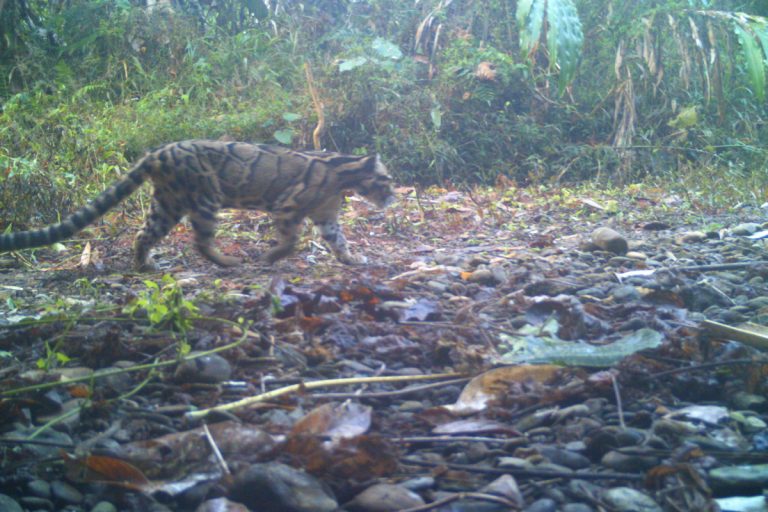- For the first time, scientists have estimated the density of the marbled cat in continental Asia.
- The researchers also estimated a density of about five clouded leopards per 100 square kilometers in Dampa Tiger Reserve in India, which they say is the highest recorded density of clouded leopards in Asia.
- The seemingly high densities of marbled cats and clouded leopards in Dampa could be because larger cats like leopards and tigers are rarer in the area, researchers say.
Several wildcats that trudge through the tropical forests of South and Southeast Asia still remain a mystery.
The house-cat sized marbled cat (Pardofelis marmorata), for instance, is one of the most secretive and little-known wildcats occurring in the region. Scientists have caught glimpses of the strikingly patterned cat in images and videos captured by motion-sensitive camera traps, but they still know very little about the cat’s population numbers or what threatens its survival in the wild. The only population density estimate for these cats is known from the island of Borneo.
Now, scientists have the first-ever estimate of population density of the marbled cat from continental Asia.
In a study published in the Journal of Mammology, researchers Priya Singh, affiliated to Researchers for Wildlife Conservation (RWC) in Bangalore, India, and David W. Macdonald of the Wildlife Conservation Research Unit at the University of Oxford, have also estimated the population density of the elusive clouded leopard (Neofelis nebulosa).

To get to the numbers, Singh and her team set up a grid of 148 camera traps in the rugged terrain of the Dampa Tiger Reserve in the state of Mizoram in northeast India. The most difficult part of the field work, Singh said, was to ensure the safety of her team “in an environment rife with incidents of kidnapping, and camera thefts and damage.”
From the photographs captured by the cameras, the team identified 10 individuals each of the marbled cat and the clouded leopard (coat patterns of both wildcats are unique to each individual). Finally, the study estimated a density of five marbled cats per 100 square kilometers (~38.6 square miles), making it only the second such estimate from any part of the species’ range.
The researchers also estimated a density of about five clouded leopards per 100 square kilometers in Dampa, which they say is the highest recorded density of clouded leopards in Asia.
The seemingly high densities of marbled cats and clouded leopards in Dampa could be because larger cats like leopards and tigers are rarer in the area, Singh said.
“That apart, the landscape surrounding our study area in Dampa is undergoing vast scale land-use changes triggered by conversion of land for monocultures of palm-oil, and an expansion of area under frequent jhum cultivation,” she added, referring to a form of slash-and-burn agriculture. “This in-turn could have resulted in an artificial inflation of clouded leopard numbers in the adjoining relatively well-protected core area of Dampa that formed our study area.”

“The science of this study is excellent,” said Dr. Alan Rabinowitz, CEO of Panthera, the global wild cat conservation organization, who was not involved in the study. “And I believe that these are probably two of the best density estimates that have been obtained for these species to date.”
However, Rabinowitz added that he would hesitate to call the clouded leopard density “one of the highest in Asia”.
“First of all the density is comparable to another study, and there are so few estimates that have been done, that I am not certain that this is a high density at all, versus perhaps an optimal or carry capacity density,” he said. “Also, I think that this study was done better than previous work, so while I think these density estimates stand as an excellent benchmark, we need much more data before making relative comparisons.”
Singh agreed that while the density estimates for the two cats seem high compared to those from other parts of their range, the actual numbers are still on the lower side.
“A density estimate of [around] five per 100 square kilometers is indeed very surprising for a small carnivore, found in a forested habitat with relatively high prey presence,” said Singh.
Data like these are, however, very important when trying to understand carnivore interactions or for planning conservation efforts, said Rabinowitz.
“These densities are also important because they show that in relatively intact forest areas, these secretive, little known species can survive in good numbers,” he added.

Citation:
- Singh P and Macdonald DW (2017) Populations and activity patterns of clouded leopards and marbled cats in Dampa Tiger Reserve, India. Journal of Mammalogy, Volume 98, Issue 5, 3 October 2017, Pages 1453–1462, DOI:10.1093/jmammal/gyx104.